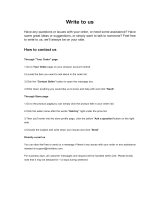
3 | P a g e
Introduction
Small, simple and affordable, Dwyer data loggers can measure and record data at specified intervals
ranging from once every 2 seconds, to once every 12 hours. Dwyer's Data Recording Software
requires no programming skills, and enables the user to effortlessly select reading rate, specify the
user's ID, and initiate the start of data collection. For immediate use of the data logger refer to the
Quick Start Guide.
In addition, all data can be saved in a format easily read by spreadsheet applications such as
"Microsoft Excel." or "Lotus 1-2-3.". It is our goal to bring you accurate, low-cost, easy-to-use data
loggers that integrate easily into the user's working environment. To better understand your needs
and to better serve you, we welcome and appreciate your feedback.
Thank you for choosing Dwyer for your data logging requirements.
Warranty
Products manufactured by Dwyer Instruments, Inc., are warranted against defective material and
workmanship for a period of one year, starting from the date of shipment. In the event that a Dwyer
product is found to be defective, Dwyer will repair or replace the product at its sole discretion. Such
repair or replacement shall be the sole remedy of this warranty.
This warranty extends only to the original purchasing customer and does not apply to any unit, which
in our sole judgment, has been subjected to:
• Operating or environmental conditions in excess of our written specifications or
recommendations;
• Damage, misuse or neglect;
• Improper installation, repair or alteration.
This warranty excludes batteries.
Except as to title, this is our only warranty for the products. Dwyer Instruments, Inc. expressly
disclaims all other warranties, guarantees or remedies whether expressed or implied or
statutory including any implied warranty of merchantability or fitness for a particular purpose. We
also disclaim any implied warranty arising out of trade usage or out of a course dealing or course of
performance. We do not guarantee the integrity of data or warranty that the products will operate
uninterrupted or error-free. Dwyer data loggers and their associated software have been thoroughly
tested and the documentation reviewed. However, Dwyer does not warrant the performance of its
products, or that the products or their associated software will operate as described in this manual.
Battery Warning
Most Dwyer data loggers contain a lithium battery. Do not cut the battery open, incinerate, or
recharge. Do not heat lithium batteries above 85ºC unless the battery is specifically rated for higher
temperatures. Dispose the battery in accordance with local regulations.
Battery Replacement
Most Dwyer miniature data loggers contain a user-replaceable 3.6 volt or 3.0 volt lithium battery.
Replacement batteries may be purchased from the factory along with installation instructions. Before
attempting to replace a battery, call customer service to ensure the device has a user-replaceable
battery. If the device does not have a user-replaceable battery, or the customer simply does not wish
to replace the battery themselves, the device may be returned to the factory for service. In this case,
the customer should contact the company from which the unit was purchased for an Return




















